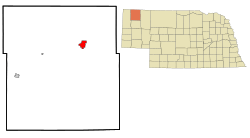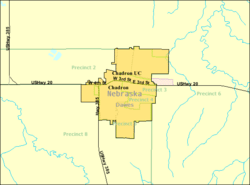Chadron, Nebraska facts for kids
Quick facts for kids
Chadron, Nebraska
|
|
|---|---|

The Chadron Commercial Historic District, a historic area in Chadron, August 2010
|
|

Where Chadron is located in Dawes County and Nebraska
|
|

A closer look at Chadron on a map
|
|
| Country | United States |
| State | Nebraska |
| County | Dawes |
| Area | |
| • Total | 3.90 sq mi (10.11 km2) |
| • Land | 3.90 sq mi (10.11 km2) |
| • Water | 0.00 sq mi (0.00 km2) |
| Elevation | 3,383 ft (1,031 m) |
| Population
(2020)
|
|
| • Total | 5,206 |
| • Density | 1,334.19/sq mi (515.17/km2) |
| Time zone | UTC−7 (Mountain (MST)) |
| • Summer (DST) | UTC−6 (MDT) |
| ZIP code |
69337
|
| Area code(s) | 308 |
| FIPS code | 31-08605 |
| GNIS feature ID | 2393793 |
| Website | chadron-nebraska.com |
Chadron (say it: SHAD-run) is a city in Nebraska, a state in the United States. It's the main town, or county seat, of Dawes County. Chadron is located in the wide-open Great Plains region. In 2020, about 5,206 people lived there.
Contents
What is Chadron Like?
Chadron is an important place for nature. It is the main office for several National Forests and National Grasslands. These include the Nebraska and Samuel R. McKelvie National Forests. It also manages the Buffalo Gap, Fort Pierre, and Oglala National Grasslands.
Near Chadron, you can find the Museum of the Fur Trade. This museum is built where the American Fur Company once had a trading post. It teaches visitors about the history of fur trading.
Chadron's History
For thousands of years, different groups of indigenous peoples lived in the Chadron area. Later, tribes like the Oglala Lakota (Sioux) and Cheyenne used this land for hunting. They were important groups in the region's history.
How Chadron Got Its Name
Chadron is named after a man called Louis Chartran. He was a French-Indian (Métis) fur trapper. In 1841, he ran a trading post right on Chadron Creek. He was married to a Native American woman.
The Town Moves!
The town of Chadron officially started in 1884. This happened when the Fremont, Elkhorn, and Missouri Valley Railroad was built through the area. The railroad was coming from Omaha, Nebraska, and heading towards Wyoming.
Chadron was first called O'Linn. It was named after its founder, Fannie O'Linn. She built a small community where the White River and Chadron Creek meet. This was supposed to be where the railroad would split off. But the railroad was built six miles away! So, the people of O'Linn did something amazing. They packed up the entire town, including the buildings, and moved it to the new railroad location.
A Future President's Family
Among the people who helped start the town were businessman Charles Henry King and his wife, Martha. Charles King opened stores, shipping businesses, and banks along the railroad's path. He helped many settlers and pioneers moving into the area.
Four of the King children were born in Chadron. One of them was Leslie Lynch King. In 1908, the family moved to Omaha. Leslie Lynch King later became the biological father of Gerald Ford, who would become a President of the United States.
The Great Cowboy Horse Race
In 1893, Chadron was the starting point for a very exciting event. It was the 1,000-mile "Chadron-Chicago Cowboy Horse Race." This race was held during the 1893 Chicago World's Fair. Nine riders competed to be the first to reach the entrance of Buffalo Bill's Wild West Show in Chicago. The prize was $1,000! A famous former outlaw named Doc Middleton was one of the riders. John Berry won the race in just 13 days and 16 hours.
Chadron in Lakota
In the Lakota language, Chadron is known as čhápa wakpá otȟúŋwahe. This means "beaver river city."
Geography and Weather
Chadron is located about 3,400 feet above sea level. It is surrounded by wide prairie grasslands. To the south, there are some hills with light forests.
The city covers about 3.85 square miles (10.11 square kilometers) of land. There is no water area within the city limits.
The Chadron "C"
If you look to the south of Chadron, you can see a large letter C on a hillside. This is a famous landmark for the city.
Chadron's Climate
Chadron has a humid continental climate. This means it has four distinct seasons. Summers are usually hot, but the temperature can change a lot between day and night. Winters are quite cold, with temperatures often in the teens (around -10 to -5 degrees Celsius). It doesn't rain or snow a lot throughout the year, but May and June get the most precipitation.
The highest temperature ever recorded in Chadron since 1987 was 109°F (43°C) in July 2006. The lowest was a very cold -40°F (-40°C) in December 1989.
| Climate data for Chadron, Nebraska, (1991–2020 normals, extremes 1894–present) | |||||||||||||
|---|---|---|---|---|---|---|---|---|---|---|---|---|---|
| Month | Jan | Feb | Mar | Apr | May | Jun | Jul | Aug | Sep | Oct | Nov | Dec | Year |
| Record high °F (°C) | 70 (21) |
80 (27) |
96 (36) |
93 (34) |
98 (37) |
107 (42) |
110 (43) |
114 (46) |
110 (43) |
94 (34) |
86 (30) |
78 (26) |
114 (46) |
| Mean maximum °F (°C) | 58.4 (14.7) |
62.6 (17.0) |
75.8 (24.3) |
81.7 (27.6) |
89.5 (31.9) |
96.5 (35.8) |
101.7 (38.7) |
100.9 (38.3) |
96.8 (36.0) |
86.4 (30.2) |
72.9 (22.7) |
61.2 (16.2) |
102.2 (39.0) |
| Mean daily maximum °F (°C) | 38.2 (3.4) |
40.9 (4.9) |
51.5 (10.8) |
59.4 (15.2) |
69.1 (20.6) |
81.1 (27.3) |
89.3 (31.8) |
88.4 (31.3) |
79.0 (26.1) |
63.6 (17.6) |
50.1 (10.1) |
39.3 (4.1) |
62.5 (16.9) |
| Daily mean °F (°C) | 25.3 (−3.7) |
27.7 (−2.4) |
37.2 (2.9) |
45.1 (7.3) |
55.5 (13.1) |
66.4 (19.1) |
74.0 (23.3) |
72.3 (22.4) |
62.3 (16.8) |
48.2 (9.0) |
35.8 (2.1) |
26.2 (−3.2) |
48.0 (8.9) |
| Mean daily minimum °F (°C) | 12.5 (−10.8) |
14.5 (−9.7) |
23.0 (−5.0) |
30.9 (−0.6) |
41.9 (5.5) |
51.7 (10.9) |
58.6 (14.8) |
56.1 (13.4) |
45.7 (7.6) |
32.8 (0.4) |
21.5 (−5.8) |
13.1 (−10.5) |
33.5 (0.8) |
| Mean minimum °F (°C) | −10.1 (−23.4) |
−8.1 (−22.3) |
3.6 (−15.8) |
15.4 (−9.2) |
27.1 (−2.7) |
39.2 (4.0) |
47.4 (8.6) |
44.3 (6.8) |
31.4 (−0.3) |
14.7 (−9.6) |
1.9 (−16.7) |
−6.7 (−21.5) |
−18.0 (−27.8) |
| Record low °F (°C) | −28 (−33) |
−44 (−42) |
−26 (−32) |
−8 (−22) |
17 (−8) |
31 (−1) |
37 (3) |
31 (−1) |
15 (−9) |
−13 (−25) |
−16 (−27) |
−40 (−40) |
−44 (−42) |
| Average precipitation inches (mm) | 0.55 (14) |
0.64 (16) |
1.34 (34) |
2.16 (55) |
2.99 (76) |
3.22 (82) |
1.93 (49) |
1.70 (43) |
1.50 (38) |
1.39 (35) |
0.69 (18) |
0.64 (16) |
18.75 (476) |
| Average snowfall inches (cm) | 5.8 (15) |
8.6 (22) |
7.9 (20) |
5.6 (14) |
1.4 (3.6) |
0.0 (0.0) |
0.0 (0.0) |
0.0 (0.0) |
0.0 (0.0) |
4.7 (12) |
6.3 (16) |
10.0 (25) |
50.3 (128) |
| Average precipitation days (≥ 0.01 in) | 4.1 | 5.5 | 5.6 | 8.7 | 11.0 | 9.0 | 7.2 | 6.7 | 6.0 | 5.7 | 4.3 | 5.1 | 78.9 |
| Average snowy days (≥ 0.1 in) | 4.0 | 5.2 | 3.6 | 2.7 | 0.6 | 0.0 | 0.0 | 0.0 | 0.0 | 1.7 | 3.5 | 5.1 | 26.4 |
| Source: NOAA | |||||||||||||
Festivals and Events
Every July, Chadron holds a special event called "Fur Trade Days." This celebration honors the city's beginnings as a fur trading post. The Museum of the Fur Trade in Chadron is the biggest of its kind in the United States. Thousands of people visit it each year.
Getting Around Chadron
Chadron has its own airport, called Chadron Municipal Airport. For getting around town, Chadron City Transit offers a "dial-a-ride" service. This means you can call and arrange for a ride within the city.
Main Roads
 US 20
US 20 US 385
US 385
Schools in Chadron
Chadron has several schools and colleges:
- Chadron State College
- Chadron Senior High School
- Chadron Middle School
- Chadron Intermediate School
- Chadron Primary School
Media in Chadron
You can find local news and entertainment in Chadron through:
Radio Stations
- KCSR 610 (AM radio)
- KCNB, 94.7 (FM radio)
- KQSK, 97.5 (FM radio)
- KCNE, 91.9 (FM radio)
- KBPY, 107.7 (FM radio)
Newspaper
- The Chadron Record
Famous People from Chadron
Many interesting people have connections to Chadron, including:
- Poe Ballantine, a writer of novels and essays
- Don Beebe, a former professional football player in the NFL
- Justin Bruening, a television actor
- James Dahlman, who was mayor of Omaha, Nebraska for a long time
- Mary E. Smith Hayward, a businesswoman who owned the M. E. Smith & Co. Twin Stores in Chadron for 50 years
- Charles Henry King, a businessman known for helping to start Chadron and other towns. He was the father of Leslie Lynch King.
- Leslie Lynch King, Sr., the biological father of President Gerald Ford
- Tim Walz, the current governor of Minnesota (since 2019)
- Danny Woodhead, a former professional football player, known for playing with the New England Patriots and San Diego Chargers. He holds many college football records.
See also
 In Spanish: Chadron (Nebraska) para niños
In Spanish: Chadron (Nebraska) para niños

